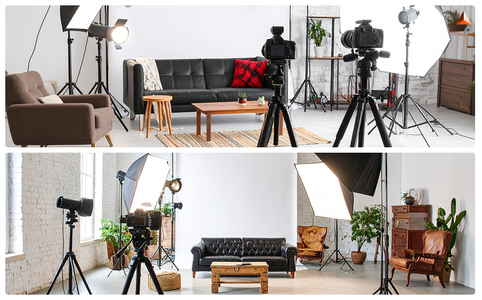In today’s commerce landscape, success isn’t just about having great products—it’s about presenting them in the right way, to the right audience, at the right time. That’s where advanced 3D automation comes in.
Thanks to innovations in 3D content creation and layout automation, merchandising has evolved from a manual, time-consuming task to a highly efficient, scalable process. Brands no longer need to rely solely on guesswork or dated visual strategies. Instead, they can create, update, and deploy layouts faster—without the bottlenecks of traditional photoshoots or long production cycles.
Let’s explore how 3D automation is transforming merchandising—and how it’s giving modern commerce teams a clear advantage.
Get the latest updates straight to your inbox.
By clicking sign up you'll receive occasional emails from imagine.io. You always have the choice to unsubscribe within every email you receive.
What is Merchandising with 3D Automation?
At its core, 3D automation is about using digital tools to create and update product layouts, planograms, and visual assets quickly, accurately, and at scale. It draws from reusable 3D assets, customizable templates, and rule-based scene setups to make it easy for teams to:
- Present products in multiple styles and layouts instantly
- Produce shelf-ready visuals for different retail requirements
- Keep content fresh and relevant without costly reshoots
It helps answer questions like:
- How can we create more layouts in less time?
- How can we adapt the same product visuals for multiple channels?
- How can we make our merchandising workflow more efficient and scalable?
Why Traditional Merchandising isn’t Enough Anymore

Traditional visual merchandising is often manual, slow, and resource-heavy. Merchandisers and creative teams depend on photoshoots, physical samples, and long lead times—making it hard to adapt to fast-changing retail needs.
Key limitations of traditional methods:
- Weeks of delay between ideation and execution
- Inability to produce multiple variations quickly
- Limited personalization and adaptability
- Resource-intensive content production
- Challenges in keeping visuals consistent across platforms
In short, it’s too rigid for today’s dynamic commerce expectations.
Also Read This: 3D Rendering vs. Traditional Photography: Which is Right for Your Business?
How 3D Automation Transforms Merchandising

3D automation doesn’t just make content creation faster—it makes it infinitely more flexible and scalable.
1. Rapid Content Creation
Instead of booking locations, shipping samples, or setting up studios, platforms like imagine.io allow teams to generate high-quality product visuals in virtual environments. Lifestyle renders, product spinners, in-context layouts—created in hours, not weeks.
2. Auto-Generated Layout Variations
Want to display the same sofa in five living room styles for different buyer personas? Or show 30 variations of your product line in shelf-ready mockups for different retailers? 3D automation handles that with reusable assets and rule-based scene setups—at scale.
3. Interactive and Immersive Shopping Experiences
3D visuals don’t just sit pretty. They allow shoppers to zoom, spin, customize, or explore product setups in full context—helping brands present products in ways that feel engaging and realistic.
The Feedback Loop: From Concept to Execution
With 3D automation, your merchandising process is never static. You can create, test, and update layouts quickly—adapting to seasonal changes, new campaigns, or shifting product priorities. This agility closes the gap between creative intent and market execution.
Who Benefits?
3D automation impacts nearly every part of your go-to-market strategy:
- Creative Teams get a faster, more consistent way to build visuals.
- Marketing Teams deliver high-quality content across platforms with ease.
- Sales Teams use better-looking product visuals to engage buyers.
- Executives and CMOs see shorter timelines, reduced costs, and scalable systems that eliminate creative bottlenecks.
Final Thoughts
Merchandising is no longer about static images and fixed layouts. It’s about creating adaptable, scalable, and visually compelling product presentations that can keep up with the pace of modern commerce.
As brands move toward more agile and visual-first merchandising models, tools like imagine.io are becoming essential for delivering high-quality layouts—faster, more consistently, and without the limits of traditional production.
If your team is still relying on slow, manual content creation, it’s time to evolve. Ready to see how 3D automation can elevate your merchandising? Book a Demo and discover how imagine.io helps leading brands build layouts that perform—before they even go live.


.gif?width=1296&height=1296&name=Untitled%20design%20(8).gif)




.png?width=500&name=How%20to%20Add%20a%203D%20Product%20Configurator%20to%20Your%20WordPress%20Website%20(Complete%20B2B%20Guide).png)
















%20(1).png?width=500&name=Why%20Exploded%20Mattress%20Views%20Matter%20(And%20How%20to%20Generate%20Them)%20(1).png)
.png?width=500&name=Best%20Shopify%20Product%20Configurator_%20How%20to%20Choose%20the%20Right%20One%20(2).png)
.png?width=500&name=Why%20Exploded%20Mattress%20Views%20Matter%20(And%20How%20to%20Generate%20Them).png)



.png?width=500&name=Best%20Shopify%20Product%20Configurator_%20How%20to%20Choose%20the%20Right%20One%20(1).png)







.png?width=500&name=How%203D%20Rendering%20Can%20Make%20or%20Break%20Your%20Industrial%20Design%20Pitch%20(1).png)








%20with%20Digital%20Twins%20and%203D%20Visualization.png?width=500&name=Optimizing%20Your%20Digital%20Asset%20Management%20(DAM)%20with%20Digital%20Twins%20and%203D%20Visualization.png)




.png?width=500&name=Styling%20Home%20Decor%20for%202025_%20From%20Global%20Influences%20to%20Playful%20Personalization%20(1).png)
